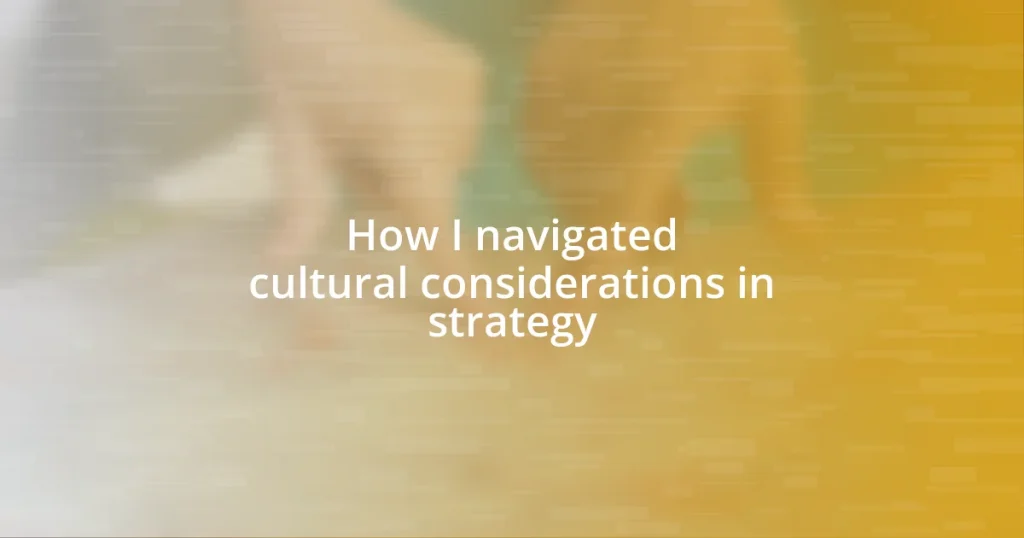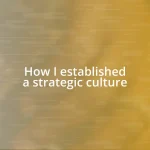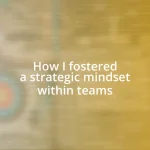Key takeaways:
- Building personal relationships and understanding cultural communication styles are crucial for effective collaboration in diverse settings.
- Adapting strategies to align with cultural values, beliefs, and practices, such as communal decision-making or storytelling, enhances engagement and ownership within teams.
- Measuring success goes beyond quantitative metrics; incorporating qualitative feedback and emotional engagement reflects the effectiveness of cultural strategies.

Understanding cultural considerations
Cultural considerations are everything when developing a strategy, and I learned this firsthand during a project in Asia. I remember feeling overwhelmed as I navigated through unfamiliar customs and business practices; it was eye-opening. Have you ever been in a situation where you felt the weight of cultural differences? It pushed me to rethink my approach and truly listen.
One thing that struck me was the significance of building relationships. In my experience, some cultures prioritize personal connections over transactional interactions. I once attended a meeting in which small talk about family and traditions took precedence over the agenda. This made me realize how essential it is to engage on a personal level—doing so can lay a strong foundation for collaboration and trust.
Another aspect is understanding communication styles. Some cultures embrace directness, while others favor subtlety. I recall a discussion where my direct approach was seen as insensitive, leading to misunderstandings. This taught me to adapt my communication strategy, carefully selecting my words and tone to align with the cultural context. How do you tailor your communication when faced with diverse perspectives? It’s all about being mindful and respectful of those differences.

Identifying key cultural factors
In my journey of identifying key cultural factors, I realized that values and beliefs play a crucial role. For instance, during a project in a Latin American country, I found that family hierarchy was paramount. A colleague shared a heartfelt story about how decisions were often made with the family in mind, rather than just focusing on numbers or outcomes. This insight made me appreciate the depth of cultural nuances; understanding such beliefs helped me align my strategies more effectively.
I also encountered various approaches to time and deadlines. When working in Europe, I noticed a more fluid interpretation of time compared to my structured approach in the U.S. An experience that stands out was when a project meeting was delayed for an hour due to unexpected personal issues of team members. Initially, it frustrated me, but it dawned on me that prioritizing personal circumstances is viewed as a sign of respect there. Acknowledging these differences allowed me to adapt my expectations and maintain strong working relationships.
Lastly, I found that symbols and gestures are laden with significance in different cultures. For example, while presenting in the Middle East, I inadvertently gestured with my left hand, which is generally considered disrespectful. A local colleague took me aside afterward and kindly explained this cultural difference. This experience reinforced the importance of awareness; even small actions can impact perceptions and relationships in an intercultural context.
| Cultural Factor | Example from Experience |
|---|---|
| Values and Beliefs | Family hierarchy in decision-making in Latin America |
| Approaches to Time | Fluid interpretations of deadlines in Europe |
| Symbols and Gestures | Left hand gesture in the Middle East as disrespectful |

Assessing cultural impacts on strategy
Assessing the cultural impacts on strategy requires a deep dive into how cultural nuances affect decision-making processes. Reflecting on my time in Asia, I encountered an unexpected challenge when presenting strategies that I thought were universally applicable. Instead, I learned that concepts like hierarchy and respect shaped interpretations greatly. I vividly remember sitting through a meeting where the emphasis was placed less on the presentation and more on the relationships we cultivated around the table. It forced me to reconsider what success looked like.
To effectively assess cultural impacts, I focus on specific elements that help me navigate these complexities:
- Decision-Making: Understanding if decisions are made individually or collectively, as seen in my experience with family-oriented cultures.
- Conflict Resolution: Identifying preferred methods for addressing disagreements—some cultures may prioritize dialogue, while others may value direct confrontation.
- Risk Tolerance: Recognizing varying levels of risk aversion, which can significantly influence strategic choices.
- Feedback Styles: Being aware of how positive and negative feedback is delivered can shape team dynamics and overall morale.
- Negotiation Approaches: Adapting to whether negotiations are seen as a zero-sum game or a collaborative effort can greatly affect outcomes.
Each of these factors was a learning opportunity for me, leading to enhanced strategies that truly resonate with the local context. Embracing these insights has not only improved my strategic outcomes but deepened my appreciation for the rich tapestry of human interaction in a globalized world.

Integrating culture into strategic planning
Integrating culture into strategic planning is a crucial step that I’ve learned to prioritize. I remember a particular project in a Southeast Asian country where the local team had a strong emphasis on communal decision-making. Initially, I approached the situation with a top-down strategy that I thought would expedite our efforts. However, I soon found that my push for quick decisions alienated my colleagues. By shifting my focus to include their perspectives, I not only enhanced our strategy but also fostered a sense of ownership within the team.
In another instance, while working with a team in Africa, I realized that storytelling played an essential role in sharing strategic visions. Instead of relying solely on data-heavy presentations, I began weaving narratives that resonated with the local culture. I remember one session where a team member recounted a traditional tale that underscored the importance of resilience. This moment was transformative; it helped us connect on a deeper level, allowing for meaningful exchanges that enriched our planning process.
Ultimately, I’ve come to see strategic planning as a collaborative art form. How often do we consider the richness of a culture when brainstorming ideas? I’ve learned that incorporating cultural insights not only rationalizes decisions but also cultivates an environment of trust and respect. It’s mesmerizing how these diverse cultural threads can weave a stronger, more innovative strategic fabric, creating something far greater than what we could achieve alone.

Adapting strategies for cultural alignment
Adapting strategies for cultural alignment often requires humility and a willingness to learn. For instance, during a project launch in Latin America, I noticed an underlying sense of personal connection that was crucial to getting buy-in from stakeholders. Initially, I focused solely on the technical aspects of our pitch, but as I observed the interactions around me, I recognized the need to build relationships first. By taking the time to share stories about our team and our mission, I was able to shift the conversation and gain both trust and enthusiasm around our proposal.
I also remember a time when I misread the expectations of a team based in Eastern Europe, where the importance of direct, honest feedback is paramount. My approach leaned towards diplomacy, crafted from my previous experiences in more indirect cultures. However, I quickly learned that they appreciated straightforward communication. By embracing this approach and encouraging open discussions, we cultivated a more dynamic collaboration. This adjustment not only strengthened our strategy but also laid the groundwork for future projects, as we established a culture of transparency.
It’s fascinating how these cultural adaptations can transform our strategies. Have you ever considered how a small shift in perspective might lead to significant improvements in your approach? From my experience, even minor tweaks, like adjusting communication styles or being mindful of local customs, can foster deeper engagement and ensure that strategic initiatives resonate. In my journey, I’ve seen firsthand how embracing cultural diversity not only enhances strategy but also enriches our professional experiences, creating a workplace that embraces differences and celebrates unity.

Measuring success of cultural strategies
Measuring the success of cultural strategies often hinges on both qualitative and quantitative metrics. One of the most insightful methods I’ve employed is conducting one-on-one interviews post-project, asking team members how they felt about their involvement in the process. This approach has revealed a wealth of emotions and valuable feedback that numbers alone simply can’t capture. For instance, after a collaboration in the Middle East, I learned that when team members felt culturally respected, they not only engaged more actively but also took pride in their contributions, which was a metric hard to quantify but deeply significant.
Another effective measurement technique I’ve utilized is assessing employee turnover and retention rates, particularly after implementing culturally informed strategic shifts. In one instance, after adjusting our communication style to align with indigenous practices in Australia, we experienced a noticeable decrease in turnover within that team. It was evident that fostering a more culturally resonant workplace led to greater job satisfaction. Have you ever experienced how a simple change in approach can drive retention? It’s not just about the strategies we implement but also about how they touch on personal and collective identities.
Lastly, I find that success isn’t purely a tangible outcome; it also manifests in the ongoing relationships we cultivate. Regular check-ins and pulse surveys allow for real-time feedback on cultural alignment within strategic aims. One memorable moment came after a project in Brazil when a team member expressed feeling more valued and heard than ever before. This emotional engagement, which we tracked through follow-up surveys, underscored the effectiveness of our cultural strategy. Isn’t it amazing how measuring success can transcend numbers and reflect the human element in our strategic endeavors?

Continuous learning and adaptation
Continuously learning and adapting within cultural contexts is an integral part of my journey. I recall a project where I partnered with a team in Southeast Asia. Initially, I operated under the assumption that formal presentations would convey professionalism, but I soon realized that a more casual, conversational approach resonated better. This shift not only fostered a relaxed atmosphere but also encouraged deeper engagement and creativity among team members. Does this kind of flexibility resonate with your own experiences?
Adaptation is not just about changing processes; it’s a mindset. In one instance, after working on a project in sub-Saharan Africa, I found myself reflecting on how local knowledge transformed our strategies. We scheduled informal coffee chats to discuss cultural nuances, learning directly from our partners about their expectations and unique practices. This openness to listening not only enriched our strategies but built genuine camaraderie. Have you ever noticed how such informal settings can lead to breakthroughs in understanding?
Moreover, there’s an emotional layer to continuous adaptation that often gets overlooked. I once led a cross-cultural team and saw firsthand how acknowledging and celebrating local festivals brought immense joy. It humanized our collaboration, turning deadlines into moments for cultural exchange. Each small adaptation, like this, became a thread in the fabric of our teamwork, weaving a richer understanding of each other’s backgrounds and values. Isn’t it incredible how these personal touches can elevate a work environment and make it feel more like a community?















